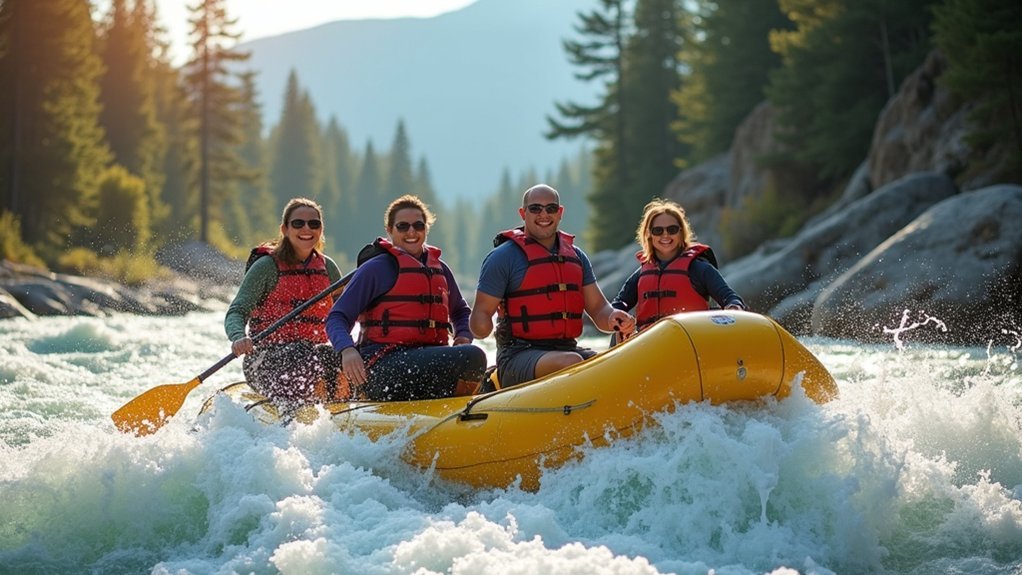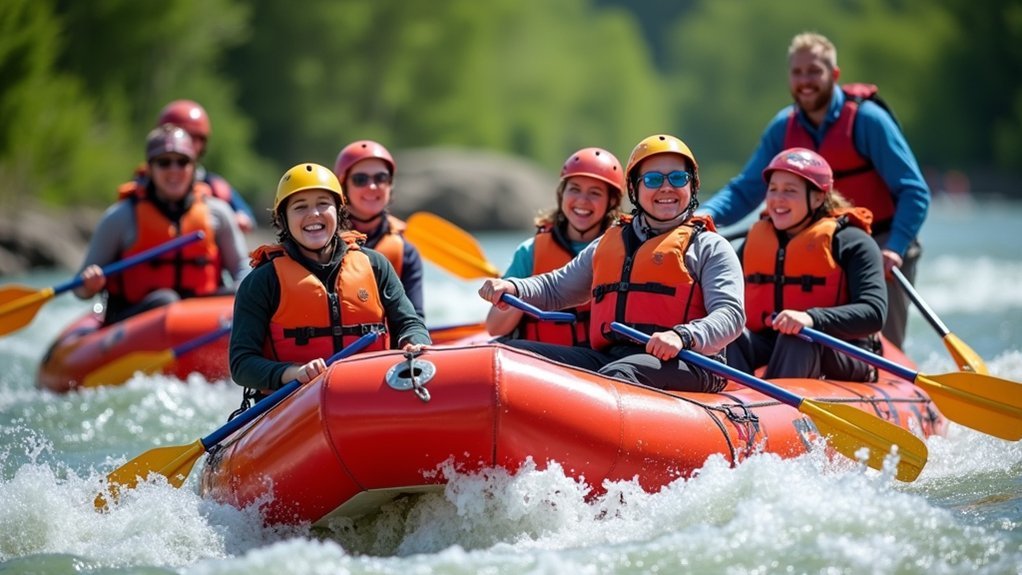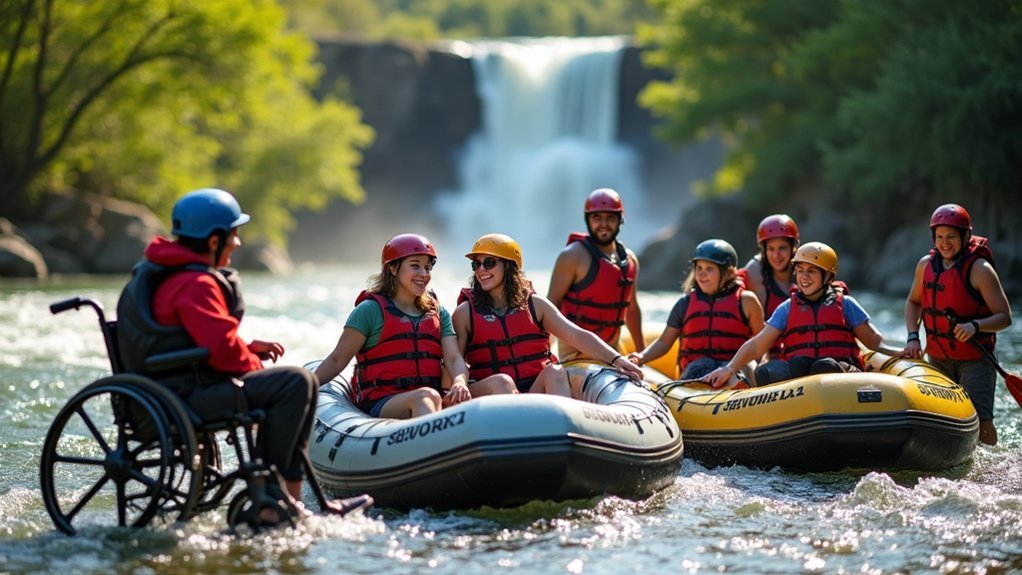Whitewater rafting has become accessible through innovative adaptations like inflatable roll cages, high-back seats, and roll-out mesh walkways that accommodate various abilities. You’ll find trained guides using adaptive communication techniques while offering trips across different difficulty levels from gentle Class I to challenging Class V rapids. Custom gear modifications and supportive staff guarantee everyone from mobility-challenged individuals to families with children can participate safely. These inclusive experiences foster community through shared challenges and personal triumphs on the water.
The Power of “Dignity in Risk” in Adaptive Whitewater Adventures

Freedom—that exhilarating rush of adrenaline as water crashes against the raft—belongs to everyone, regardless of physical ability. This principle forms the foundation of dignity in risk, a concept that champions your right to experience life’s thrilling adventures.
When you’re traversing churning rapids alongside others, something remarkable happens. You’re not defined by limitations but by courage. Organizations like Splore understand this transformation, creating spaces where you can safely push boundaries while building self-esteem and personal empowerment.
The beauty of adaptive whitewater rafting lies in its ability to dissolve artificial barriers. You’ll find yourself confronting fears, challenging societal expectations, and connecting through shared emotions with fellow adventurers.
These moments of vulnerability and triumph on the river create community where differences fade against the backdrop of shared human experience.
Innovative Gear Modifications That Transform Rafting Accessibility
While traditional rafting equipment once presented barriers, today’s innovative gear modifications have revolutionized accessibility on the water. You’ll find inflatable roll cages and high back seats providing stability for guests with mobility limitations, guaranteeing everyone can safely enjoy the rapids.
Custom adaptations like rigged wheelchairs mounted directly onto rafts and supportive leg slings address specific needs without compromising safety. Even simple solutions like plastic lawn chairs have proven effective as stable seating options, debunking myths that wheelchair users can’t participate.
The innovative adaptations extend beyond the boats themselves. Roll-out mesh walkways create accessible paths to launching points, while modified groover tents and personal supply stations guarantee comfort for all participants throughout the journey.
These thoughtful modifications transform what was once exclusive into an inclusive adventure.
Universal Design Principles for Inclusive River Experiences

Because water doesn’t discriminate between abilities, universal design principles guarantee rafting experiences don’t either. These principles transform standard equipment and procedures into adaptive solutions that work for everyone on the water.
Water creates equal opportunity adventures. Smart design makes it possible for all paddlers to ride the same waves.
When you’re planning your next adventure, look for operators who embrace these universal design principles:
- Inflatable roll cages and high-back seats that provide stability and support for various mobility levels
- Accessible entry points with safe navigation trails to and from the water
- Customizable gear modifications like leg slings that enhance comfort without compromising safety
- Clear communication protocols that respect individual needs and create a supportive environment
Training Guides to Support Diverse Abilities on the Water
When you’re seeking an accessible rafting experience, knowledgeable guides can make all the difference between frustration and fulfillment.
Guides trained in adaptive communication techniques will tailor instructions to your specific needs, whether you require visual demonstrations, tactile guidance, or simplified verbal cues.
Your safety and enjoyment depend on guides who understand how to modify their approach without compromising the adventure or your dignity.
Guide Knowledge Matters
Knowledgeable, well-trained guides serve as the foundation of accessible whitewater rafting experiences. Through specialized guide training programs, these professionals learn to communicate effectively with participants of all abilities, creating an environment where everyone feels safe and included.
When guides understand that not all disabilities are visible, they can better anticipate needs and foster trust. Their proactive approach makes all the difference in your adventure experience.
The best guides prioritize:
- Building rapport through consent-seeking behaviors
- Initiating dialogue to identify individual comfort needs
- Recognizing and accommodating diverse abilities on the water
- Collecting feedback to continuously improve their support techniques
This commitment to understanding participants’ unique requirements guarantees that your rafting experience will be exciting, comfortable, and tailored to your specific needs.
Adaptive Communication Techniques
Three essential communication strategies transform the rafting experience for participants of all abilities.
First, practice proactive dialogue that anticipates needs before they arise, recognizing that not all disabilities are visible. You’ll build trust faster when you establish consent for even minor adjustments like fixing a life jacket or offering physical support.
Second, don’t shy away from potentially awkward conversations. Addressing comfort needs directly prevents misunderstandings during rafting trips. Ask open-ended questions like “What would make you more comfortable today?” rather than making assumptions.
Finally, adapt your instructions to be clear and specific. Effective adaptive communication techniques include seeking input about gear requirements and personal supplies.
When guides create space for participants to express their needs, everyone enjoys a more inclusive adventure on the water.
Navigating Physical Considerations Without Limiting Participation

You’ll find adaptive equipment like high-back seats and inflatable roll cages that make rafting accessible regardless of mobility challenges.
Trained support staff can rig wheelchairs securely to boats and help you navigate the entire rafting experience from put-ins to take-outs.
Whether you’re a beginner seeking Class II waters or an adventurer ready for more challenging rapids, trip options with varying difficulty levels guarantee everyone can enjoy the thrill of whitewater.
Adaptive Equipment Options
While physical limitations might seem like barriers to experiencing the thrill of whitewater rafting, today’s adaptive equipment innovations have transformed accessibility on the water.
Specialized gear now empowers you to participate fully in the adventure regardless of mobility challenges.
The latest adaptive equipment options include:
- Inflatable roll cages and high-back seats providing essential support and safety while enhancing comfort during your river journey
- Custom paddle modifications allowing you to steer using only arm strength when lower body mobility is limited
- Secure wheelchair rigging systems and leg slings that offer additional stability during rapids
- Universal design elements such as accessible groovers and personally tailored gear accommodations
Operators like South Eastern Expeditions and Arizona Raft Adventures specialize in these adaptations, with trained guides who understand how to maximize your experience through thoughtful equipment solutions.
Trained Support Staff
Consistently, the most vital element in accessible whitewater rafting isn’t the equipment but the people who operate it. Trained support staff identify your unique needs and create an environment where you’ll feel both safe and included on the water.
Guides receive specialized training to communicate effectively about comfort levels and necessary accommodations, fostering trust throughout your adventure. They’re equipped to secure wheelchairs on boats and utilize adaptive gear that enhances your safety without compromising participation.
What sets exceptional rafting experiences apart is proactive communication. Staff anticipate needs before they arise, offering tailored assistance that promotes independence rather than dependency.
With knowledgeable guides by your side, you’ll engage fully in the rafting experience while feeling supported—regardless of physical abilities.
Varied Difficulty Levels
Whitewater rafting adventures accommodate diverse physical abilities through strategically designed difficulty levels, ensuring everyone can experience the thrill of rushing rapids.
You’ll find options ranging from gentle Class I waters to extreme Class VI challenges, with something suitable for every skill level.
For groups with mixed abilities, consider these accommodations:
- Section III offers Class II-IV rapids, perfect for families with children as young as 8 years old.
- Section IV provides more intense Class III-V experiences for advanced rafters.
- Basic float tests help guides assess your comfort level in water before starting.
- Adaptive equipment is available to assist with mobility challenges and paddling needs.
With these varied difficulty levels, your whitewater adventure doesn’t have to be limited by physical considerations—there’s an appropriate challenge waiting for everyone.
Building Community Through Shared River Challenges
Beyond the rush of rapids and scenic beauty, river rafting creates a unique social ecosystem where strangers become allies.
You’ll find yourself bonding with people from diverse backgrounds as you collectively navigate challenges, building trust with each paddle stroke.
The river doesn’t discriminate—it demands teamwork from everyone. Many participants, like Kenny, return not just for adventure but for the profound connections formed when facing fears together.
This shared vulnerability builds lasting relationships that extend beyond the water.
Adaptive rafting programs further enhance this inclusivity, allowing people with various disabilities to experience the same sense of accomplishment and belonging.
When you’re conquering white water as a team, differences fade while community strengthens, creating a powerful shared identity through collective triumph.
Real Success Stories: Overcoming Barriers to Whitewater Thrills
Real success stories from participants demonstrate the profound impact of these adventures:
- A woman with mobility challenges conquering class III rapids using specialized high-back seating.
- A visually impaired man steering through whitewater guided by detailed verbal instructions.
- A veteran with PTSD finding peace and community through structured river experiences.
- A child with developmental disabilities building confidence through progressively challenging trips.
These triumphs exemplify how innovative gear modifications and thoughtful accommodations make thrilling river experiences possible for everyone, fostering personal growth and creating lasting connections through shared adventure.
Frequently Asked Questions
Why Is White Water Rafting Popular?
You’ll love white water rafting for its perfect blend of thrilling adventure and natural beauty. It’s popular because it offers excitement, builds community connections, and provides both physical and mental benefits.
What Is the Fatality Rate of Whitewater Rafting?
The fatality rate for whitewater rafting is approximately 0.03 deaths per 1,000 participants. You’re facing relatively low risk, especially if you wear a life jacket and choose appropriate rapids for your experience level.
Who Should Not Go White Water Rafting?
You shouldn’t go whitewater rafting if you have severe mobility impairments, serious medical conditions, are pregnant, can’t pass a float test, or are an inexperienced swimmer lacking water confidence.
How Fit Do You Have to Be for White Water Rafting?
You’ll need a moderate fitness level for whitewater rafting. Some upper body strength helps with paddling, and core stability is essential for balance. Don’t worry—guides teach techniques that don’t rely on brute strength.
In Summary
You’ve discovered that whitewater rafting isn’t limited by ability, age, or experience. Through adaptive equipment, trained guides, and inclusive design, you can feel the rush of rapids regardless of your physical challenges. Whether you’re a senior, someone with a disability, or a nervous first-timer, the river welcomes you. Remember, accessibility isn’t about removing adventure—it’s about creating pathways so everyone can experience the thrill of whitewater.





Leave a Reply